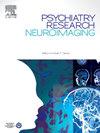用fNIRS分析N-Back任务中以M1受体多态性为特征的精神分裂症组功能连接差异
IF 2.1
4区 医学
Q3 CLINICAL NEUROLOGY
引用次数: 0
摘要
本研究的重点是m1受体多态性(rs2067477)对接受氯氮平单药治疗的精神分裂症患者功能连接模式的影响。尽管先前的研究表明m1受体多态性与精神分裂症患者的认知功能之间存在关系,但研究结果却相互矛盾。在早期的工作中,我们对治疗难治性精神分裂症患者进行了fNIRS实验,观察到m1受体多态性对N-back表现没有影响;然而,在与工作记忆相关的区域,观察到皮层活动的显著差异。目前的研究调查了这些患者组的功能连接模式是否存在差异。采用小波变换相干性方法观察患者组整体和任务级连通性的差异。结果表明,与非野生型相比,野生型个体在前额叶和前运动皮层的任务相关区域表现出更高的大脑激活,但在额颞叶网络的功能连通性较低。这些差异表明遗传变异在形成对氯氮平的神经反应中可能发挥的作用,野生型个体表现出更有效的神经策略,而非野生型个体依靠更广泛、更低效率的代偿过程来维持认知表现。本文章由计算机程序翻译,如有差异,请以英文原文为准。
Analysis of functional connectivity differences in Schizophrenia groups characterized by M1 receptor polymorphism during the N-Back task with fNIRS
This study focuses on the impact of M1-receptor polymorphism (rs2067477) on functional connectivity patterns of patients with schizophrenia receiving clozapine monotherapy. Although previous work suggested a relationship between M1-receptor polymorphism and cognitive function in schizophrenia, there are contradictory findings. In earlier work, we conducted an fNIRS experiment with treatment resistant schizophrenia patients and observed that the M1-receptor polymorphism did not have an effect on N-back performance; however, significant differences in cortical activity were observed at regions associated with working memory. The current study investigates whether there are differences in the functional connectivity patterns of these patient groups. Wavelet Transform Coherence method was utilized to observe overall and task-level differences in the connectivity profiles of patient groups. The results revealed that wild-type individuals exhibit higher brain activation in task related cortical regions in the prefrontal and premotor cortex, but lower functional connectivity in the fronto-temporal network compared to non-wild-types. These differences indicate the possible role of genetic variations in shaping the neural response to clozapine, with wild-type individuals displaying more efficient neural strategies, whereas non-wild-type individuals rely on broader, less efficient compensatory processes to sustain cognitive performance.
求助全文
通过发布文献求助,成功后即可免费获取论文全文。
去求助
来源期刊
CiteScore
3.80
自引率
0.00%
发文量
86
审稿时长
22.5 weeks
期刊介绍:
The Neuroimaging section of Psychiatry Research publishes manuscripts on positron emission tomography, magnetic resonance imaging, computerized electroencephalographic topography, regional cerebral blood flow, computed tomography, magnetoencephalography, autoradiography, post-mortem regional analyses, and other imaging techniques. Reports concerning results in psychiatric disorders, dementias, and the effects of behaviorial tasks and pharmacological treatments are featured. We also invite manuscripts on the methods of obtaining images and computer processing of the images themselves. Selected case reports are also published.

 求助内容:
求助内容: 应助结果提醒方式:
应助结果提醒方式:


